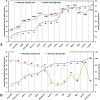Women's empowerment as a determinant of neonatal mortality in Sub-Saharan Africa: a narrative review focused on Nigeria
- PMID: 39193753
- PMCID: PMC11360643
- DOI: 10.1080/16549716.2024.2394256
Women's empowerment as a determinant of neonatal mortality in Sub-Saharan Africa: a narrative review focused on Nigeria
Abstract
Neonatal mortality remains a critical public health issue, with Sub-Saharan Africa (SSA) experiencing disproportionately high rates compared to other global regions. Notably, SSA and South Asia are the regions most lagging behind the Sustainable Development Goal (SDG) 3.2, aiming for <12 neonatal deaths per 1,000 live births by 2030. Within SSA, Nigeria, the most populous country, records the highest number of neonatal deaths annually. Given the structural similarities among SSA nations, this narrative review, focusing on Nigeria, explores effective strategies to reduce the neonatal mortality gap. Information about trends, risk factors, and prevalent lapses was obtained from literature from renowned databases like PubMed, Scopus, and Google Scholar, and grey literature consisting of reports from relevant governmental and non-governmental organizations. Critical risk factors commonly identified include inadequate antenatal care (less than three visits), lack of access to skilled and clean birth practices, limited healthcare accessibility, financial barriers, substandard environmental conditions, and nutritional shortfalls. This review highlights women's empowerment as an additional critical factor, often overlooked, in the efforts to decrease neonatal mortality rates. Improving women's empowerment indices, such as the Gender Inequality Index (GII), employment, and literacy, offers a promising avenue to curtail neonatal mortality rates in Nigeria and across SSA sustainably. While this is potentially a long-term solution, short and medium-term recommendations were also proffered. By integrating women's empowerment within a broader strategy to improve maternal and newborn health, Nigeria can advance towards securing a healthier future for its youngest population.
Keywords: Neonates; gender equality; sustainable development goal 3; women and girls; women’s empowerment.
Plain language summary
Main findings: Neonatal mortality remains a major public health crisis in SSA, even with sustained local and global efforts.Added knowledge: Sustainably resolving this crisis requires a holistic approach that includes women’s empowerment, a factor that is often overlooked in current interventions to curb neonatal mortality.Global health impact for policy and action: Prioritizing women’s empowerment will contribute to sustainably reducing neonatal mortality rates and will also help address other prevalent public health and economic challenges facing developing countries.
Conflict of interest statement
No potential conflict of interest was reported by the author(s).
Figures




Similar articles
-
Temporal relationship between Women's empowerment and utilization of antenatal care services: lessons from four National Surveys in sub-Saharan Africa.BMC Pregnancy Childbirth. 2021 Mar 10;21(1):198. doi: 10.1186/s12884-021-03679-8. BMC Pregnancy Childbirth. 2021. PMID: 33691651 Free PMC article.
-
The Effect of Early Marriage Timing on Women's and Children's Health in Sub-Saharan Africa and Southwest Asia.Ann Glob Health. 2017 May-Aug;83(3-4):557-567. doi: 10.1016/j.aogh.2017.10.005. Epub 2017 Nov 8. Ann Glob Health. 2017. PMID: 29221529
-
Examining the mechanisms by which women's status and empowerment affect skilled birth attendant use in Senegal: a structural equation modeling approach.BMC Pregnancy Childbirth. 2017 Nov 8;17(Suppl 2):341. doi: 10.1186/s12884-017-1499-x. BMC Pregnancy Childbirth. 2017. PMID: 29143630 Free PMC article.
-
Associations of women's empowerment with neonatal, infant and under-5 mortality in low- and /middle-income countries: meta-analysis of individual participant data from 59 countries.BMJ Glob Health. 2020 Jan 9;5(1):e001558. doi: 10.1136/bmjgh-2019-001558. eCollection 2020. BMJ Glob Health. 2020. PMID: 32133162 Free PMC article.
-
Reduction of maternal and perinatal mortality in rural and peri-urban settings: what works?Eur J Obstet Gynecol Reprod Biol. 1996 Oct;69(1):47-53. doi: 10.1016/0301-2115(95)02535-9. Eur J Obstet Gynecol Reprod Biol. 1996. PMID: 8909956 Review.
References
-
- UNICEF . Neonatal mortality [internet]. UNICEF data: monitoring the situation of children and women. 2024. [cited 2024 Mar 16]. Available from: https://data.unicef.org/topic/child-survival/neonatal-mortality/#:~:text...
Publication types
MeSH terms
LinkOut - more resources
Full Text Sources
Research Materials
Miscellaneous
